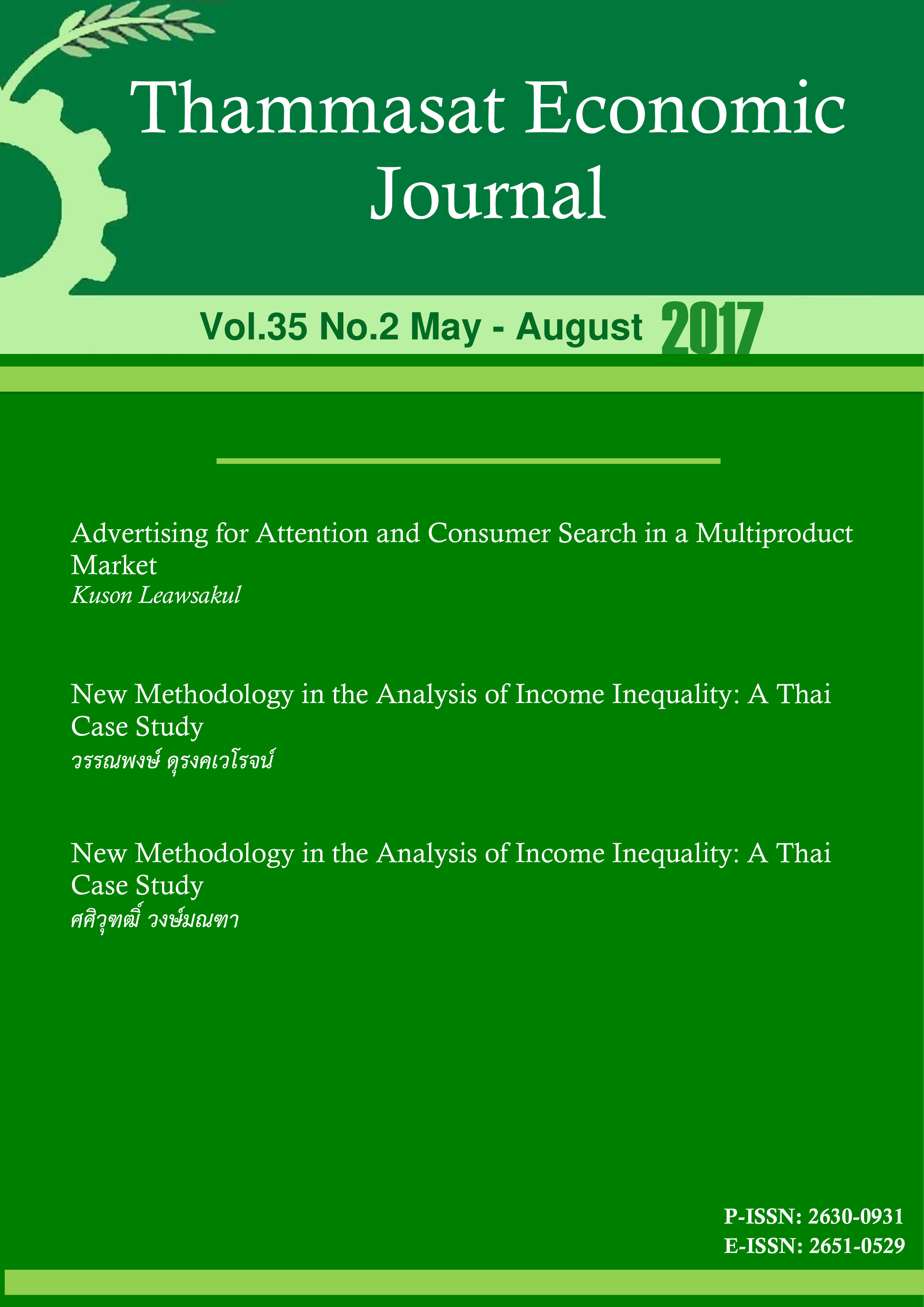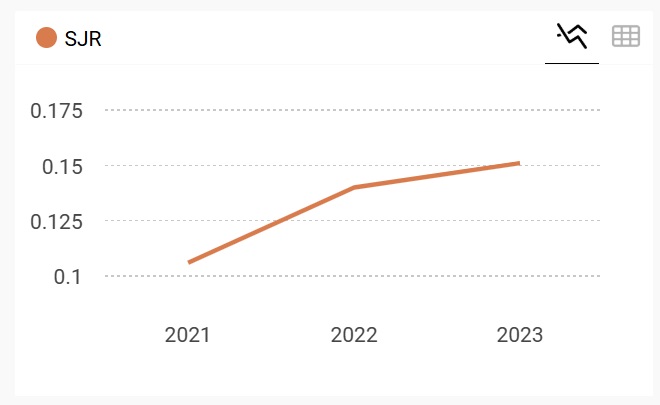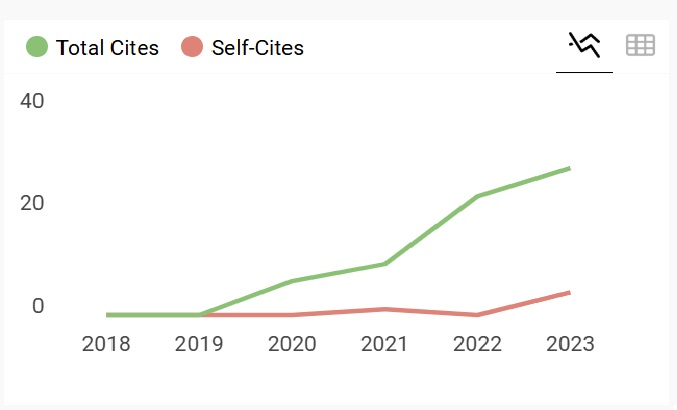New Methodology in the Analysis of Income Inequality: A Thai Case Study
Keywords:
Inequality, Economic growth, IncomeAbstract
The purpose of this study was to develop a measurement that can be used to analyze income inequality by applying an Input - Output table. In this case it was applied to Thai trade data. The study precisely constructed a model displaying changes in income distribution throughout the economy when economic growth exists. In the case of Thailand, there is still a problem of income inequality, but the situation has gradually improved over the past 30 years. However, Thailand's distribution of income is likely to be negatively affected by exogenous shocks, for example, economic crises and natural disasters. Moreover, the results from applying this model revealed both conformity and unconformity, with the Gini coefficient acting as a key indicator of income inequality.
References
Aguiar, M., & Bils, M. (2015). Has consumption inequality mirrored income inequality?. The American Economic Review, 105(9), 2725-2756.
Ahluwalia, M. (1974). Income inequality - some dimensions of the problem. Finance & Development, 11(3), 2-8.
Alesina, A., & Rodrik, D. (1994). Distributive politics and economic growth. The Quarterly Journal of Economics, 109(2), 465-490.
Bank of Thailand. (2014). Southern economy. Retrieved from https:// www.bot.or.th.
Barro, R. (1999). Inequality, growth and investment. NBER Working Paper No.7038, National Bureau of Economic Research.
Bellu, L. G. & Liberati, P. (2006). Inequality analysis: The gini index. EASYPol Module 040: Food and Agriculture Organization of the United Nations.
Blundell, R., & Preston, I. (1998). Consumption inequality and income uncertainty. The Quarterly Journal of Economics, 113(2), 603-640.
Cowell, F.A. & Flachaire, E. (2007) Income distribution and inequality measurement: The problem of extreme values, Journal of Econometrics, 141(2), 1044-1072
Fields, G. (1980). Poverty, inequality, and development. Cambridge England: Cambridge University Press.
Fishlow, A. (1972). Brazilian size distribution of income. The American Economic Review, 62(1-2), 391-402.
Garvy, G. (1952). Inequality of income: Causes and measurement in NBER Book Series Studies in Income and Wealth Vol.15, National Bureau of Economic Research.
Goodman, A. & Oldfield, Z. (2004). Permanent differences? Income and expenditure inequality in the 1990s and 2000s. London: The Institute for Fiscal Studies.
Henry, M. S. and T. L. Martin. (1984). Estimating income distribution effects on regional input-output multipliers. Journal of Regional Analysis and Policy, 14(2), 1-13.
Industrial Estate Authority of Thailand. (n.d.). Northern region industrial estate. Retrieved from https://www.ieat.go.th/northern.
Kaldor, N. (1960). Essays on value and distribution. London: G. Duckworth.
Kalecki, M. (1971). Selected essays on the dynamics of the capitalist economy 1933-1970. Cambridge England: Cambridge University Press.
Kuznets, S. (1955). Economic growth and income inequality. American Economic Review, 45(1), 1-28.
Kalecki, M. (1963). Quantitative aspects of the economic growth of nations: VII, distribution of income by size. Economic Development and Cultural Change 2(2), 1-80.
Loehr, W., & Powelson, J. (1981). The economics of development and distribution. New York: Harcourt Brace Jovanovich.
De, M. (2007). Income inequality measures. Journal of Epidemiology and Community Health, 61(10), 849-852.
Miller, R., & Blair, P. (2009). Input-output analysis: Foundations and extensions (2nd ed.). Cambridge England: Cambridge University Press.
Miyazawa, K. (1968). Input-output analysis and interrelational income multiplier as a matrix. Hitotsubashi Journal of Economics, 8(2), 39-58.
Moreira, G., Almeida, L., Guilhoto, J., & Azzoni, C. (2008). Productive structure and income distribution: The Brazilian case. Quarterly Review of Economics and Finance, 48(2), 320-332.
National Economic and Social Development Board. (2015a). Gini coefficient (expenditure) by regions between 1988 - 2014. Retrieved from https://nesdb.go.th.
National Economic and Social Development Board. (2015b). Comparison of average debt between the poor and non-poor household. Retrieved from https://nesdb.go.th.
National Economic and Social Development Board. (2015c). The proportion of income by a group of population (quintiles) between 1988 - 2013. Retrieved from https://nesdb .go.th.
National Economic and Social Development Board. (2015d). Average of monthly expenditure and its change by a group of population (quintiles) between 1988 - 2014. Retrieved from https://nesdb.go.th.
Office of Agricultural Economics. (2016). Price of palm oil (monthly) at farmer price between 1997 - 2016. Retrieved from https://oae.go.th.
Papanek, G. & Kyn, O. (1986). The effect on income distribution of development, the growth rate and economic strategy. Journal of Development Economics, 23(1), 55-65.
Partridge, M. (1997). Is inequality harmful for growth? Comment. The American Economic Review, 87(5), 1019-1032.
Pineda, j. & F. Rodriguez. (1999). The political economic of human capital accumulation. Mimeo: Department of economics, University of Maryland.
Rubber Authority of Thailand. (2016). Monthly price of rubber 2013 - present. Retrieved from https://www.rubberthai.com.
Seers, D. (1969). The meaning of development. Brighton. Institute of Development Studies.
Todaro, M. P. & S. C. Smith. (2009). Economic development. Harlow, England: Pearson Education Limited.
Weisskoff, R. (1970). Income dstribution and economic growth in Puerto Rico, Argentina, and Mexico. Review of Income and Wealth, 16(4), 303-332.
World Bank. (2014). Introduction to poverty analysis. Washington DC: World Bank Group.
World Bank. (2016). World Development Index. Retrieved from https://www.worldbank .org.









